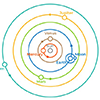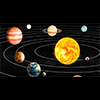Discoveries in Astronomy
Aryabhata's contributions to the field of astronomy were significant and far-reaching, revolutionizing the way people understood the cosmos during his time. Some of his key contributions include:

Heliocentrism
Aryabhata proposed a heliocentric model of the solar system, where he suggested that the Earth rotates on its axis and orbits the Sun. This idea challenged the prevailing geocentric model and laid the groundwork for later astronomers to explore the nature of the solar system.

Earth's Rotation
Aryabhata correctly theorized that the apparent daily motion of the stars and celestial objects was due to the rotation of the Earth on its axis. He provided an explanation for phenomena like the rising and setting of the Sun and stars.

Annual Motion of the Sun
Aryabhata calculated the length of a year with remarkable accuracy. He determined that a year consists of 365 days and 6 hours, a value very close to the modern value.

Lunar and Solar Eclipses
Aryabhata explained the causes of lunar and solar eclipses. He understood that eclipses occur due to the shadows cast by the Earth and the Moon. His work included methods to predict these eclipses, which were significant advancements in the field.

Celestial Motions
Aryabhata made observations of the motion of planets and their apparent retrograde motion. He provided explanations for these complex motions and attempted to describe the patterns observed in the night sky.

Astronomical Constants
Aryabhata introduced certain fundamental astronomical constants, such as the length of a day and the eccentricity of Earth's orbit, into his calculations.
Aryabhata's insights and calculations significantly advanced the understanding of astronomy during his era. His works were influential not only within India but also among scholars in other parts of the world. Later astronomers, both Indian and non-Indian, built upon his ideas and contributed to the ongoing development of astronomy.